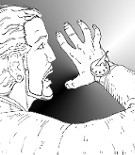Template:Are You Sure/May 11: Difference between revisions
From Gnomon Chronicles
(Created page with "• ... that theoretical physicist '''Richard Phillips Feynman''' (1918–1988) shared the 1965 Nobel Prize in Physics with Julian Schwinger...") |
No edit summary |
||
| Line 1: | Line 1: | ||
[[File:Feynman diagram showing space-time vectors of electron-positron annihilation.svg|thumb|175px|link=Feynman diagram (nonfiction)|A '''[[Feynman diagram (nonfiction)|Feynman diagram]]''' showing space-time vectors of electron-positron annihilation.]] | |||
• ... that theoretical physicist '''[[Richard Feynman (nonfiction)|Richard Phillips Feynman]]''' (1918–1988) shared the 1965 Nobel Prize in Physics with [[Julian Schwinger (nonfiction)|Julian Schwinger]] and [[Sin'ichirō Tomonaga (nonfiction)|Sin'ichirō Tomonaga]] for their development of [[Quantum electrodynamics (nonfiction)|quantum electrodynamics]]; and that Feynman developed a widely used pictorial representation scheme for the mathematical expressions governing the behavior of subatomic particles, which later became known as [[Feynman diagram (nonfiction)|Feynman diagram]]s; and that during his lifetime, Feynman became one of the best-known scientists in the world? | • ... that theoretical physicist '''[[Richard Feynman (nonfiction)|Richard Phillips Feynman]]''' (1918–1988) shared the 1965 Nobel Prize in Physics with [[Julian Schwinger (nonfiction)|Julian Schwinger]] and [[Sin'ichirō Tomonaga (nonfiction)|Sin'ichirō Tomonaga]] for their development of [[Quantum electrodynamics (nonfiction)|quantum electrodynamics]]; and that Feynman developed a widely used pictorial representation scheme for the mathematical expressions governing the behavior of subatomic particles, which later became known as [[Feynman diagram (nonfiction)|Feynman diagram]]s; and that during his lifetime, Feynman became one of the best-known scientists in the world? | ||
Revision as of 06:30, 10 May 2020

A Feynman diagram showing space-time vectors of electron-positron annihilation.
• ... that theoretical physicist Richard Phillips Feynman (1918–1988) shared the 1965 Nobel Prize in Physics with Julian Schwinger and Sin'ichirō Tomonaga for their development of quantum electrodynamics; and that Feynman developed a widely used pictorial representation scheme for the mathematical expressions governing the behavior of subatomic particles, which later became known as Feynman diagrams; and that during his lifetime, Feynman became one of the best-known scientists in the world?
